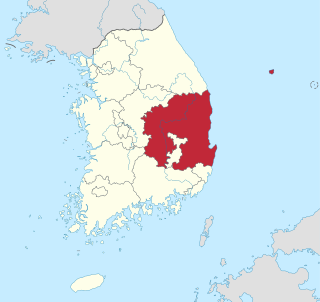
North Gyeongsang Province is a province in eastern South Korea,and with an area of 19,030 km2 (7,350 sq mi),it is the largest province in the Korean peninsula. The province was formed in 1896 from the northern half of the former Gyeongsang province,and remained a province of Korea until the country's division in 1945,then became part of South Korea.

Gyeongsang was one of the Eight Provinces of Joseon Korea. Gyeongsang was located in southeastern Korea.

Gyeongju,historically known as Seorabeol,is a coastal city in the far southeastern corner of North Gyeongsang Province,South Korea. It is the second largest city by area in the province after Andong,covering 1,324 km2 (511 sq mi) with a population of 264,091 people as of December 2012. Gyeongju is 370 km (230 mi) southeast of Seoul,and 55 km (34 mi) east of Daegu. The city borders Cheongdo and Yeongcheon to the west,Ulsan to the south and Pohang to the north,while to the east lies the coast of the Sea of Japan. Numerous low mountains—outliers of the Taebaek range—are scattered around the city.
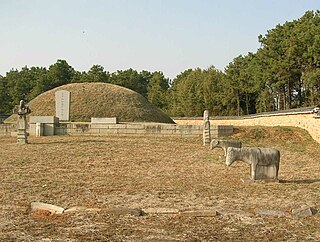
Sangju is a city in North Gyeongsang Province,central South Korea. Although Sangju is rather rural,it is very old and was once a key city. Along with Gyeongju,it gives rise to half of the name of the Gyeongsang provinces. Sangju is nicknamed Sam Baek,or "Three Whites",referring to three prominent agricultural products rice,silkworm cocoons,and dried persimmons from the area.

The Gyeongju Basin is a landform in Gyeongju city,North Gyeongsang province,South Korea. It forms part of the watershed of the Hyeongsan River,which flows north through the basin where it is joined by the Bukcheon,Namcheon,Daecheon,and Sogyeon-cheon streams.

National Treasure (Korean: 국보) is a national-level designation within the heritage preservation system of South Korea for tangible objects of significant artistic,cultural and historical value. Examples of objects include art,artifacts,sites,or buildings. It is administered by the Cultural Heritage Administration (CHA). Additions to the list are decided by the Cultural Heritage Committee.
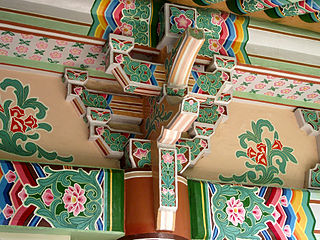
Korean architecture refers to an architectural style that developed over centuries in Korea. Throughout the history of Korea,various kingdoms and royal dynasties have developed a unique style of architecture with influences from Buddhism and Korean Confucianism.

The Gyerim is a small woodland in Gyeongju National Park,Gyeongju,South Korea. The name literally means "rooster forest." The grove lies near the old site of the Silla kingdom palace in central Gyeongju. Nearby landmarks include the Banwolseong fortress,Cheomseongdae,the Gyeongju National Museum,and the Royal Tombs Complex.

Donggung Palace and Wolji Pond,formerly known as Anapji (Korean: 안압지),is an artificial pond in Gyeongju National Park,South Korea. It was part of the palace complex of ancient Silla. It was constructed by order of King Munmu in 674 CE. The pond is situated at the northeast edge of the Banwolseong palace site,in central Gyeongju. It is an oval shape;200m from east to west and 180m from north to south. It contains three small islands.
Tourism in Gyeongju is a major industry and defining feature of Gyeongju,South Korea. Gyeongju is a major cultural site and tourist destination for South Koreans and foreigners with about 8 to 9 million visitors annually. A great deal of this is due to the city's status as a center of Silla heritage,derived from its former role as the capital of that ancient kingdom.
Gyeongju is a coastal city in the far southeastern corner of North Gyeongsang province in South Korea. It is the second largest city by area in the province after Andong,covering 1,324 square kilometres (511 sq mi) with a population of 269,343 people according to the 2008 census. The early history of Gyeongju is closely tied to that of the Silla kingdom,of which it was the capital for nearly one thousand years.

The crowns of Silla were made in the Korean kingdom of Silla approximately in the 5th–7th centuries.
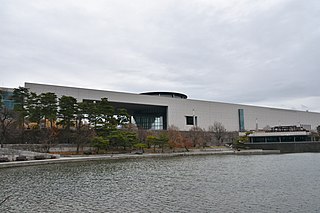
The National Museum of Korea (Korean: 국립중앙박물관) is the flagship museum of Korean history and art in South Korea. Since its establishment in 1945,the museum has been committed to various studies and research activities in the fields of archaeology,history,and art,continuously developing a variety of exhibitions and education programs.

The Gyeongju Historic Areas of South Korea were designated as a World Heritage Site by UNESCO in 2000. The protected areas encompass the ruins of temples and palaces,outdoor pagodas and statuary,and other cultural artifacts left by the Silla Kingdom. The historic areas are sometimes known as one of the largest outdoor museums in the world.

Wolseong Palace Site,Gyeongju,also commonly known as Wolseong Palace,was the royal palace compound of the Korean Silla monarchy at their capital in Gyeongju during the Silla and Unified Silla periods. It takes its name from the approximate outline of the palace walls which were shaped like a crescent moon. Banwolseong has been also known as Sinwolseong or Jaeseong,which means where the king resides.

The Seoak Seowon is a seowon located in the neighborhood of Seoak-dong,Gyeongju,North Gyeongsang Province,South Korea. Seowon was a type of local academy during the Joseon Dynasty (1392–1897). It was established by local Confucian scholars especially Yi Jeong in 1651,the second year of King Hyojong's reign,to commemorate the virtue and scholarly achievements of scholar Seol Chong,and Choe Chi-won and General Kim Yu-sin. The enshrined people played important roles in the unification of Three Kingdoms of Korea into Unified Silla.
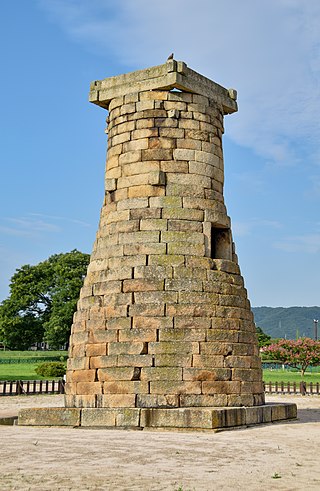
Wolseong-dong is an administrative dong or a neighbourhood in the administrative subdivisions of the Gyeongju City,North Gyeongsang province,South Korea. It consists of nine legal dong including Inwang-dong,Gyo-dong,Dongbang-dong,Doji-dong,Namsan-dong,Pyeong-dong,Guhwang-dong,Bomun-dong and Baeban-dong

Silla Arts and Science Museum is a private history and science museum located in the district of Gyeongju Folk Craft Village,Ha-dong,Gyeongju,North Gyeongsang,South Korea. It was established on 15,October,1988 by Seok U-il (昔宇一) to provide an opportunity that children and youths visiting Gyeongju could know the root of Korean science. The museum in housed in a two-story building with a basement and consists of six exhibition halls according to theme. The first exhibition room located on the first floor presents a total of seven subjects while the second exhibition room located on the basement displays models of Seokguram grotto,one of representative tangible cultural properties of Gyeongju. The third exhibition room on the west part of the second floor exhibits a model of the bronze bell at Sangwonsa temple in the real size and presents information of bell-making process.
The Gyerim-ro Dagger and Sheath are ornately decorated treasures that were excavated from an ancient Korean tomb from the Silla Kingdom in 1973. They are understood to originate from the Black Sea area,testifying to the expansiveness of the Silk Road network in the ancient world.









































